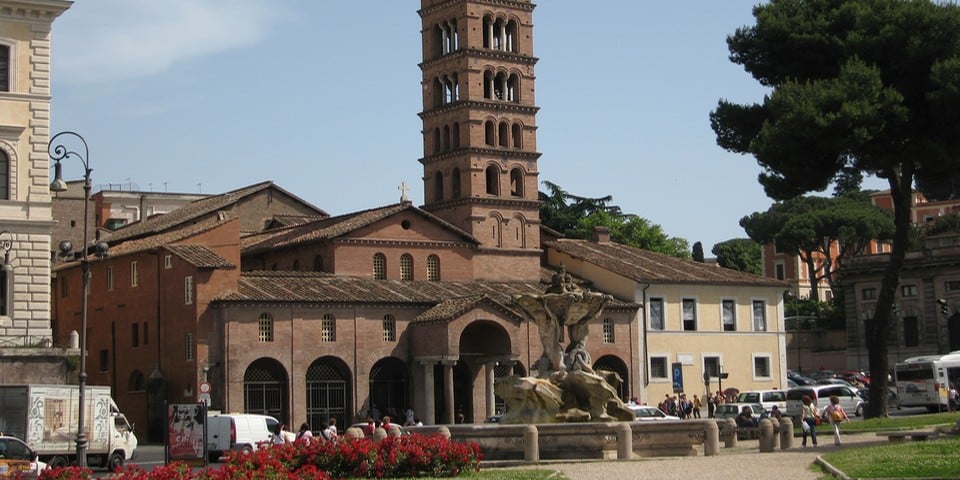

24837 views
Written by: Kate Zusmann

| Opening Hours |
Sunday:
-
Monday:
-
Tuesday:
-
Wednesday:
-
Thursday:
-
Friday:
-
Saturday:
-
|
|---|---|
| Closest bus stops |
|
| Closest subway stations |
|
| Address | Piazza della Bocca della Verità, 18, Roma |
The church of Santa Maria in Cosmedin is located in Piazza della Bocca della Verita, in the area known as the Forum Boarium, the cattle market in ancient Rome.
By taking advantage of the existing Roman structures that existed in this place in the 6th century AD, the Diakonia (a religious center made to help the poor and homeless) was called Santa Maria de Schola Graeca, and the name was taken from the Greek community who resided near the building.
Contents
TogglePope Adrian I built the Church of Santa Maria in Cosmedin in the 8th century by taking advantage of the surviving structures of two significant Roman buildings in the ancient Forum Boarium. The first reused set became the great atmosphere known as the “Loggia,” also called “Loggia dei Mercanti,” which is usually identified with the statio annonae; this is the building where the offices were set for the food supply administration of ancient Rome.
In the 6th century AD, the diaconate of St. Mary de schola graeca, and in the 8th century AD, the old building hosted the front part of the new church of St. Maria in Cosmedin. It was a large rectangular room that was supposed to be built between the 2nd and 4th century AD and was open on three sides with fluted marble columns. In contrast, the fourth side was constituted by a wall in blocks of the church’s left aisle, the central nave’s counter, and the sacristy settings.
In the 8th century AD, Adrian decided to expand the original Diakonia in schola graeca to create the church of Santa Maria in Cosmedin. However, he was forced to demolish the walls of travertine of the “Loggia” to build the presbytery, the apses, and the crypt and, behind it, a great podium in tufa Aniene, higher than 4 meters and which measured overall 21.7 x 31.5m.
Today, we attribute these remains to Ara Maxima Herculis Invicti, but the building was identified in the past with the Temple of Ceres, or the Temple of Hercules Pompeiano.
This structure was built exploiting a building from the Roman age whose high-fluted marble columns are still visible on the walls of the front part of today’s church.
In the 8th century, the diaconate was followed by the church. It was built by Pope Adrian I (772-795); because of the splendid decoration, it was renamed Santa Maria in Cosmedin (from the Greek kosmidion, which means ornamental).
The subsequent work was carried out by Popes Nicholas I (857-867), Calistus II (1119-1124), and Boniface VIII (1294-1303). Under Clement XI, between 1715 and 1719, it was carried out the requalification work of the whole area in the ancient Forum Boarium. In recent years also, Cardinal Alessandro Albani (1692-1779) maintained the baroque facade of the church (by the architect Giuseppe Sardi). In 1717 he opened the crypt under the altar, created in the first church of Adrian I, which had been forgotten by time in the following centuries.
The last substantial work which involved the exterior and interior of the church go back to the 1894-1899
The small underground crypt was created by Pope Adrian I (772-795) under the hierarchy of Santa Maria in Cosmedin church by digging the basement of a Roman building identified with the Ara Maximum of Hercules.
We can recognize the limestone blocks made up of the core of the Ara immediately outside the front door of the crypt, at the end of a stairway to the underground, and in the ceiling of the apogee.
The crypt reminds a minor basilica, divided into three naves by six columns, which were probably recycled. These columns are baseless. They are directly inserted into the pavement, and there are small travertine capitals on their top. On the bottom of the crypt, there is a small apse preceded by an altar which used to be a Roman milestone, where the relics of St. Cirilla should be kept. The crypt certainly hosted many other relics, as proved by the sixteen niches, divided into two parts by shelves arranged along the side walls and on the inner side of the entrance wall of the crypt.
We know some of these martyrs’ names from the inventories of the relics, like the already mentioned Cirilla, Adauctus, Valentino (the skull of the latter is now venerated in the left aisle of the chapel of the church), Adriano, Amelia, Antonino Clemenza, Generous, Ottavio, Patrick, Olympia, and St. John Baptist de Rossi.
Right near the entrance to the basilica, you will see the famous The Mouth of Truth (Italian: Bocca della Verità).
It is an ancient image carved in a round Pavonazzo marble (Italian: Marmo pavonazzetto) slab. The gloomy face of an unknown god is set in the portico of the church of Santa Maria in Cosmedin. The church is located on the left bank of the Tiber river, a contemporary area of ancient Roman buildings.
Scientists believe that the place has an age of about 2,200 years, and the Romans are convinced that it is impossible to tell a lie under a stern gaze of the mask!
Curious to visit these places? Book our private guided tour over ancient Rome at sunrise.
Author: Kate Zusmann
This website uses cookies. For more info read the cookies policy
Rome.us © 2025. Created with love by Roman experts and guides.